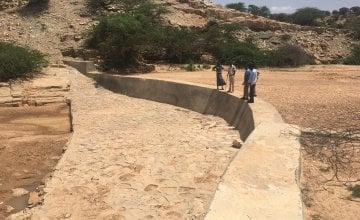
Read our 2024 annual report

Knowledge Hub
Sand Dams Research in Somaliland
This page details the findings of research into sand dams carried out as part of an MSc dissertation by Paz Lopez-Rey, Concern's Resilience Programme Coordinator in Somalia/ Somaliland.

Sand dams and sub-surface dams are increasingly recognised as low-cost and climate-resilient rainwater harvesting technologies. They have two clear advantages over open water storage infrastructure in rural semi-arid and arid lands: storage in sediment significantly reduces evaporation-loss while sand filtration reduces the risk of bacteriological contamination.
In this study, Concern appraises sand dam experiences in Somaliland and reflects on their potential to enhance water availability and build communities’ resilience.
The study
This Water, Engineering and Development Centre (WEDC - Loughborough University) MSc dissertation is a collaboration with the Concern Worldwide team to inform resilience programming. Through the study of five communities in Somaliland, this research appraises the effectiveness of sand dams as a rural water supply technology, potentially capable of positively impacting water security and resilience in semi-arid and arid environments in Somaliland. The study also presents key lessons learned from sand dam practitioners in the Horn of Africa and explores the technical, environmental, socio-economic and cultural aspects involved in the sustainable and effective management of sand dams.
Key findings
- Sand dams are a socially acceptable technology with limited social and environmental impacts, provided adequate site selection and mitigation measures are considered from the design stage.
- Water from sand dams is perceived by users to be suitable for drinking without any treatment. WHO drinking water standards of turbidity, pH and thermotolerant coliforms (TTC) can be achieved if the abstraction wells are adequately protected and facilities maintained.
- Investing in sand dams is cost-effective, requiring an average capital investment of $21-28 USD per capita for a 30-year design life.
- The results suggest affordability is not a limiting factor of sand dam’s sustainability, nor is the availability of technical services, materials and spare parts. Adequate sand dam maintenance over a 30-year lifespan ranges from $0.7 to $1.2 USD/person/year. The key limiting factors identified are: insufficient knowledge of sand dam technology, limited skills to conduct essential sand dam maintenance such as gabion repair and unwillingness to pay where convenience and accessibility is not visibly improved by the project.
Sand dams contribute to improve water security and community resilience in four critical ways:
- Safeguarding access to water supply for domestic and livestock use during the long dry season with net gains from 2 to 5 months of local water supply.
- Reducing the risk of water-borne pollution through sand filtration.
- Sustaining agro-pastoral and pastoral livelihoods by covering 58-100% of combined domestic and livestock water demand in the dry season as well as supporting livelihood diversification.
- Increasing the water table and riverine ecosystem vegetation in the long term.
The above benefits have direct causal links to improved food security, nutrition and health, which in turn contribute towards enhancing resilience capacities to cope with climate-related shocks. The study strongly recommends the piloting of sand dams in new locations of Somaliland based on existing local technical capacity, supportive public policy framework and favourable climatic and hydrogeological conditions.




